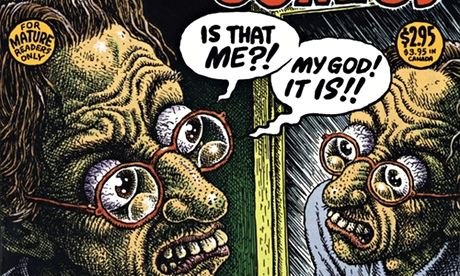
Robert Crumb – Self-Loathing Comics (1995)
Robert Crumb creates a graphic (and funny) self-portrait of age and celebrity in this intimate adult comic. The art of Crumb is fiercely honest and riskily confessional. Spurning the superheroes and violence of American mass market comics, he has forged a genuinely grown-up approach in which sexuality is openly explored. Yet what makes him a powerful artist is his ability to draw with accuracy and beauty.
Roy Lichtenstein – Torpedo … Los! (1963)
Second world war adventures were the meat and drink of boys' comics when Lichtenstein inflated a scene from one such story to colossal proportions (for a comic) and copied it in paint. His translation of the original comic's limited colours and repetitive dots revels not just in its lurid subject matter – as a U-boat prepares to fire torpedoes – but in the crudeness and stereotypical nature of what is being communicated.
William Hogarth – A Rake's Progress (1733)
The novel was just beginning to be a popular form of literature when Hogarth invented his unique brand of graphic fiction. A Rake's Progress depicts the sad course of a young spendthrift from gambling and whoring to ending up broke, mad and in Bedlam. Hogarth produced his visual narratives both as paintings and as prints to be sold to a middle-class public. These pictorial tales are among the most fascinating and haunting masterpieces of British art.
David Hockney – A Rake's Progress (1961-63)
In the age of pop art the erudite and witty Hockney revived one of its oldest sources, William Hogarth. His set of prints A Rake's Progress transplants Hogarth's hapless character to 1960s America. The prints tell of Hockney's discovery of the US and his delight in the gay culture he found there. This Rake has a happy ending: Hockney soon moved to LA in pursuit of his American dream.
Andy Warhol – Superman (1960)
When the successful New York advertising artist Andy Warhol decided to turn his hand to "fine" art one of his first ideas was to make paintings based on comics. He portrayed Superman and the comic book detective Dick Tracy but gave up this vein of pop source material when he saw what his rival Roy Lichtenstein was doing. Warhol would make his name with soup cans instead.
Giotto – the Scrovegni Chapel (Finished c 1305)
Long before comics existed, artists used bold sequences of images to tell stories. This medieval style of graphic fiction reaches a high point in Giotto's masterpiece, a chapel that can be read like a book. Giotto's Bible scenes are so exact and lucid, the expressions and gestures of his people so vivid, that his frescoes have the narrative power of a great novel, play or film.
Michelangelo – the Sistine ceiling (1508-12)
The world's most sublime comic is painted on the ceiling of the Pope's personal chapel in Rome. When Michelangelo took on this commission the traditional medieval method of comic-strip storytelling was giving way to more sophisticated single scenes that sum up an entire drama. Yet Michelangelo takes the simplicity of serial images to overpowering heights of invention as he tells the story of creation.
Alan Moore and Kevin O'Neill – The League of Extraordinary Gentlemen, Vol 1 (1999)
Writer Moore and artist O'Neill created one of the most vivid and beguiling inventions in modern British literature when they concocted this steampunk fantasia of late Victorian heroes and villains. Characters stolen from the tales of Bram Stoker and Rider Haggard fight monstrous enemies in a science fiction version of Victorian London brilliantly visualised by O'Neill. Often copied but never equalled, the series has since lost the fun of its first two volumes.
Albrecht Durer – The Apocalypse in woodcuts (1497-98)
When printing came to Europe in the 15th century, German artists saw its potential to transmit images as well as words. Durer, the first pop artist, saw no difference between his paintings and prints. In his great illustrated version of the Book of Revelations he uses the most popular and primitive kind of printmaking, the woodcut, to create such enduring images as the Four Horsemen riding roughshod over humanity.
Matt Groening – Life in Hell (1977-2012)
Before he came up with The Simpsons cartoonist Groening offered a disconcerting view of American life in this great newspaper comic strip. A classic scene shows LA in flames after a night of riots. "Now you know why it's called Life in Hell"... but Groening's deceptively simple drawings and observations also deal with family life and sexual identity in an amused, thoughtful style that elevates the newspaper cartoon to conceptual art.

